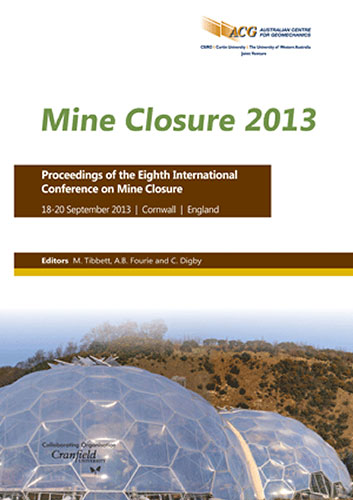Opportunities and constraints of functional assessment of mined land rehabilitation

|
Authors: Erskine, PD; Fletcher, AT; Seaborn, B |
DOI https://doi.org/10.36487/ACG_rep/1352_28_Erskine
Cite As:
Erskine, PD, Fletcher, AT & Seaborn, B 2013, 'Opportunities and constraints of functional assessment of mined land rehabilitation', in M Tibbett, AB Fourie & C Digby (eds), Mine Closure 2013: Proceedings of the Eighth International Seminar on Mine Closure, Australian Centre for Geomechanics, Cornwall, pp. 345-354, https://doi.org/10.36487/ACG_rep/1352_28_Erskine
Abstract:
This paper presents a general overview of the functional attributes of rehabilitated open-cut coal mine lands. It provides an evaluation of how classical soil analysis techniques and landscape function analysis (LFA) have been applied to ecosystems on heavily modified mined landscapes. It also compares the landscape position and placement of LFA transects to high-resolution imagery captured by an unmanned aerial vehicle. LFA was originally developed as a method for assessing soil surface conditions in the rangelands of Australia and has since been applied in other countries, ecosystems and, more recently, mine sites. The method uses quickly observed soil surface features to estimate the status of three important soil functional processes (particularly stability, infiltration and nutrient cycling), which have been proposed as indicators of ecosystem rehabilitation success. For mine site rehabilitation, LFA index scores are typically interpreted as trends over time and compared with unmined reference communities. This paper suggests that LFA transects and the LFA-generated scores do not adequately reflect the functional success of rehabilitated coal mine lands. The utility of these monitoring methods in constructed landscapes should be critically examined before future application.
References:
Carroll, R. and Minchinton, J. (2006) Progressive rehabilitation of large mines, viewed 26 April 2013, .
Chaney, K. and Swift, R.S. (1984) The influence of organic matter on aggregate stability in some British soils, Journal of Soil Science, Vol. 35, pp. 223–230.
CSIRO (Commonwealth Scientific and Industrial Research Organisation) (1999) A Guidebook to Environmental Indicators, viewed 26 April 2013, .
Dale, V.H. and Beyeler, S.C. (2001) Challenges in the development and use of ecological indicators, Ecological Indicators, Vol. 1(1), pp. 3–10.
Fletcher, G. (2006) Gregory mine rehabilitation maintenance review, Internal report for BHP Billiton Mitsubishi Alliance, 16 p.
Hartigan, J. (1980) Soil respiration as an index of forest floor metabolism, PhD thesis, University of New England.
Landloch Pty Ltd (2010) Ecosystem function analysis (EFA): rehabilitation monitoring on Collinsville coal mine, Queensland, report prepared for Xstrata Coal Pty Ltd, 27 p.
Mulligan, D.R., Gillespie, M.J., Gravina, A.J. and Currey, N.A. (2006) An assessment of the direct revegetation strategy on the tailings storage facility at Kidston gold mine, North Queensland, in Proceedings First International Seminar on Mine Closure, A.B. Fourie and M. Tibbett (eds), 13–15 September 2006, Australia, Australian Centre for Geomechanics, Perth, pp. 371–381.
Nichols, O.G. (2006) Developing completion criteria for native ecosystem reconstruction – a challenge for the mining industry, in Proceedings First International Seminar on Mine Closure, A.B. Fourie and M. Tibbett (eds), 13–15 September 2006, Australia, Australian Centre for Geomechanics, Perth, pp. 61–74.
QLD EPA (Queensland Environmental Protection Agency) (2007) Guideline 18: Rehabilitation requirements for mining projects, Queensland Government, 30 p.
Reynolds, W.D., Bowman, B.T., Brunke, R.R., Drury C.F. and Tan, C.S. (2000) Comparison of tension infiltrometer, pressure infiltrometer, and soil core estimates of saturated hydraulic conductivity, Soil Science Society of America Journal, Vol. 64, pp. 478–484.
Seaborn, V.C. (2005) An assessment of landscape function analysis as a tool for monitoring rehabilitation success in the mining industry, M. Phil Thesis, University of Queensland, Brisbane, Australia, 205 p.
Tongway, D.J. (2002) Assessing rehabilitation success: a training course to understand, assess and monitor the success of mine rehabilitation using ecosystem function analysis indicators, CSIRO, Sustainable Ecosystems, Canberra.
Tongway, D.J. and Hindley, N. (2003) Indicators of Ecosystem Rehabilitation Success. Stage Two – Verification of EFA Indicators for the Australian Centre for Mining Environmental Research, CSIRO, Sustainable Ecosystems, Canberra.
Tongway, D.J. and Hindley, N. (2004) Landscape function and analysis: procedures for monitoring and assessing landscapes, with special reference to rangelands and minesites, CSIRO, 80 p.
Tongway, D.J. and Ludwig, J.A. (2006) Assessment of landscape function as an information source for mine closure, in Proceedings First International Seminar on Mine Closure, A.B. Fourie and M. Tibbett (eds), 13–15 September 2006, Australia, Australian Centre for Geomechanics, Perth, pp. 21–29.
Tongway, D.J. and Ludwig, J.A. (2011) Landscape Function Analysis: Soil-surface Indicators, in The science and practice of ecological restoration restoring disturbed landscapes: putting principles into practice, Island Press, Washington, DC, pp. 145–150.
White, I., Sully, M. and Perroux, K. (1992) Measurement of surface-soil hydraulic properties: disc permeameters, tension infiltrometers, and other techniques, in Advances in Measurement of Soil Physical Properties: Bringing Theory into Practice, Soil Science Society of America, Madison, Wisconsin, USA, pp. 69–103.
© Copyright 2025, Australian Centre for Geomechanics (ACG), The University of Western Australia. All rights reserved.
View copyright/legal information
Please direct any queries or error reports to repository-acg@uwa.edu.au
View copyright/legal information
Please direct any queries or error reports to repository-acg@uwa.edu.au